The Intel SSD 320 Review: 25nm G3 is Finally Here
by Anand Lal Shimpi on March 28, 2011 11:08 AM EST- Posted in
- IT Computing
- Storage
- SSDs
- Intel
- Intel SSD 320
It's called the Intel SSD 320, but the part number should give away just what we're looking at here:
This is the long awaited third generation Intel based SSD. This is the G3. And at this point it's around 6 months late.
Back then it was simply called the Postville Refresh on Intel's roadmaps (Postville was the 34nm Intel X25-M G2). It would use 25nm Intel NAND, feature improved performance and full disk encryption - all behind a 3Gbps SATA interface.
When I spoke with Intel about the drive last year, all indications pointed to it being faster than drives based on SandForce's SF-1200 controller. And it is:
| Intel SSD 320 300GB vs. Corsair Force F120 | ||||
| AT Storage Bench 2011 (Heavy) | AT Storage Bench 2011 (Light) | |||
| Corsair Force F120 | 120.1 MB/s | 155.9 MB/s | ||
| Intel SSD 320 300GB | 132.8 MB/s | 161.7 MB/s | ||
Without turning to any real time compression/deduplication techniques, Intel has built a drive that's faster than the SF-1200. You also get that famed Intel SSD reliability:
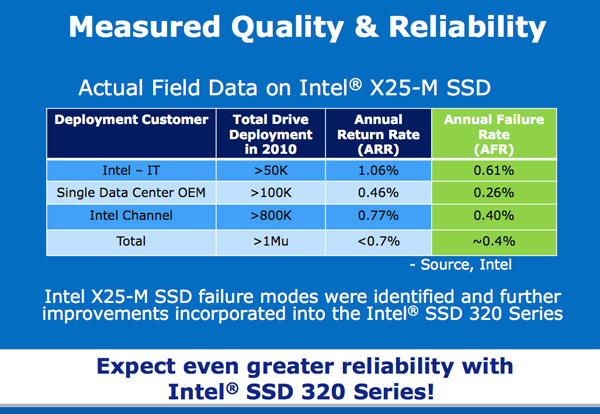
There's just one issue. The SF-1200 was the king of 2010. This year is shaping up to be all about the SF-2200 and the G3 isn't quite as competitive there. Intel realized this as well and thus we got the Intel SSD 510 to address the high performance market. Intel claims the 510 should have the same failure rate as the 34nm X25-M G2 at ~0.6% per year.
The Intel SSD 320 by comparison is aimed at the mainstream market. Remember that's what the M in X25-M always stood for to begin with. As a result we get lower pricing:
| Intel SSD Comparison | ||||||||||||
| X25-M G2 160GB | Intel SSD 320 40GB | Intel SSD 320 80GB | Intel SSD 320 120GB | Intel SSD 320 160GB | Intel SSD 320 300GB | Intel SSD 320 600GB | SSD 510 120GB | SSD 510 250GB | ||||
| User Capacity | 149GB | 37GB | 74GB | 111GB | 149GB | 279GB | 558GB | 111GB | 232GB | |||
| Random Read Performance | Up to 35K IOPS | Up to 30K IOPS | Up to 38K IOPS | Up to 38K IOPS | Up to 39K IOPS | Up to 39.5K IOPS | Up to 39.5K IOPS | Up to 20K IOPS | Up to 20K IOPS | |||
| Random Write Performance | Up to 8.6K IOPS | Up to 3.7K IOPS | Up to 10K IOPS | Up to 14K IOPS | Up to 21K IOPS | Up to 23K IOPS | Up to 23K IOPS | Up to 8K IOPS | Up to 8K IOPS | |||
| Sequential Read Performance | Up to 250MB/s | Up to 200MB/s | Up to 270MB/s | Up to 400MB/s (6Gbps) | Up to 500MB/s (6Gbps) | |||||||
| Sequential Write Performance | Up to 100MB/s | Up to 45MB/s | Up to 90MB/s | Up to 130MB/s | Up to 165MB/s | Up to 205MB/s | Up to 220MB/s | Up to 210MB/s (6Gbps) | Up to 315MB/s (6Gbps) | |||
| Price | $404 | $89 | $159 | $209 | $289 | $529 | $1069 | $284 | $584 | |||
It's still early in the 25nm ramp, but the 25nm Intel SSD 320 is cheaper than the 34nm Intel SSD 510. The only issue is that OCZ is very competitive with its pricing as well and compared to the Vertex 2, Intel's SSD 320 isn't really any cheaper. Intel likes to maintain its 65% profit margins so even though it makes the NAND and the controller in the 320, we're unlikely to see these drives drop below competitive pricing.
Intel expects the 25nm SSD 320 to be even more reliable than the 510 or X25-M.
The Same Controller
The Intel SSD 320, like the 310 and X25-M before it, uses an Intel branded controller. Opening up the 320 reveals a near identical controller to what we saw in the 34nm X25-M G2 housing:
You'll notice the part number is identical to 2009's X25-M G2 controller. In fact, it's the same controller. Apparently the G2 controller had a number of features on-die, but not implemented in firmware. Things like full disk encryption and NAND redundancy never made it out in G2 but are here in the 320 all thanks to new firmware. And no, G2 owners aren't getting it.
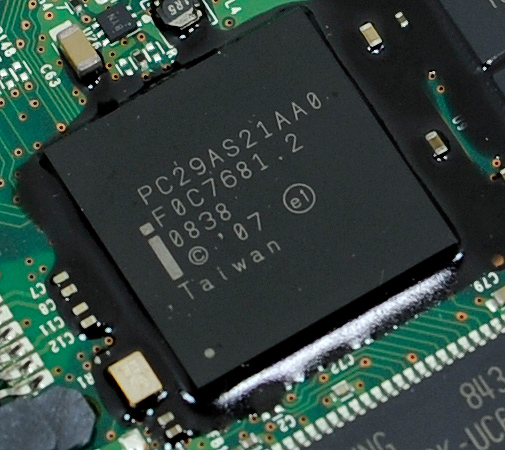
Intel's X25-M G1 Controller
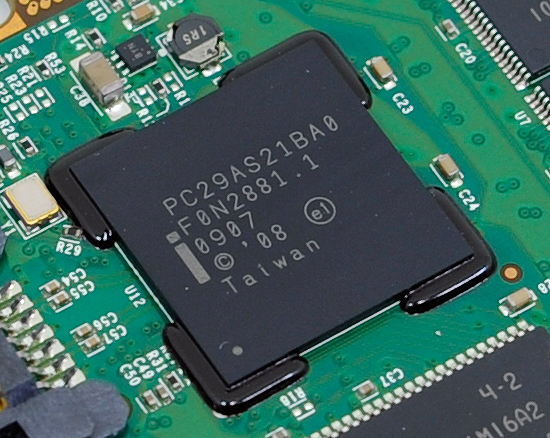
Intel's X25-M G2 Controller
Since the controller hasn't changed, the basic architecture of the SSD hasn't changed either. Intel still doesn't store any user data in its external DRAM cache and there's still a 256KB on-die SRAM.
Next to the Intel controller is a 64MB 166MHz SDRAM device, now made by Hynix. You'll notice that the DRAM chip is a lot smaller than what we've seen in previous X25-M generations, despite growing in capacity. Intel actually turned to mobile SDRAM for use in the SSD 320 to help save on power. While the X25-M G1 and G2 both used a conventional 3.3V SDRAM device, Intel moved to a 1.8V mobile SDRAM chip with the 320.
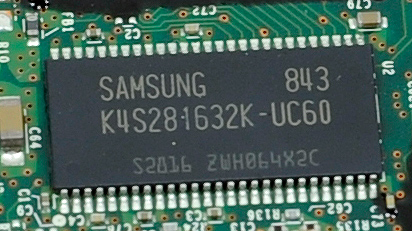
Intel X25-M G1: 16MB 166MHz SDRAM
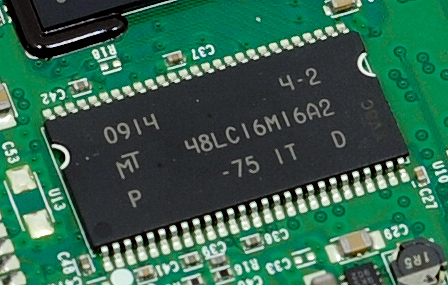
Intel X25-M G2: 32MB 133MHz SDRAM
Intel always prided itself on not storing any user data in its DRAM cache. The external DRAM is only used to cache mapping tables and serve as the controller's scratchpad. In the event of a sudden loss of power, Intel only has to commit whatever data it has in its SRAM to NAND. To minimize the amount of data loss in the event of a sudden power failure, Intel outfitted the SSD 320 with an array of six 470µF capacitors in parallel.
We've seen large capacitors on SSDs before, primarily the enterprise SandForce drives that boast a 0.09F supercap. Intel claims that for its design a single large capacitor isn't necessary given the minimal amount of data that's cached. It further claims that an array of multiple capacitors in parallel allows for much better reliability - if one capacitor fails the array is still useful (vs. a single point of failure in the case of the supercap).



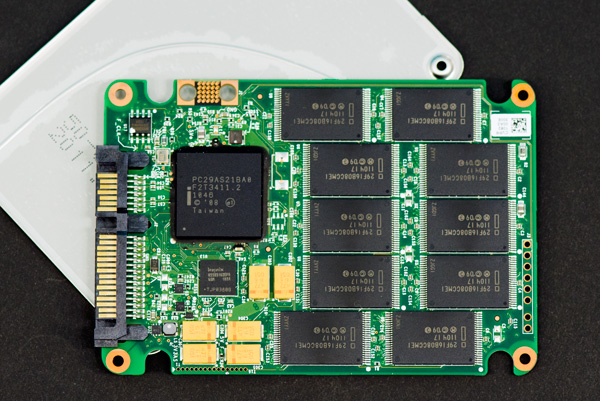
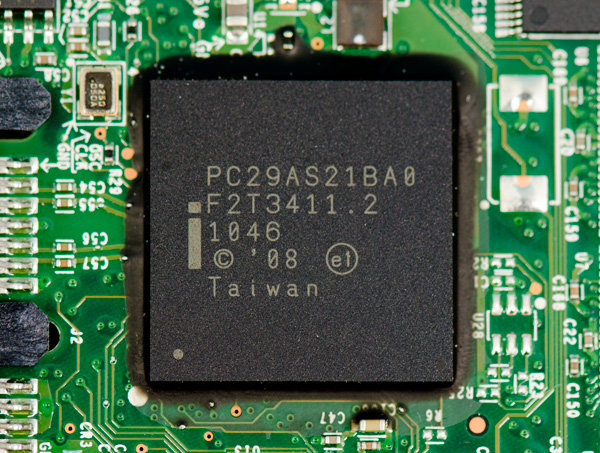
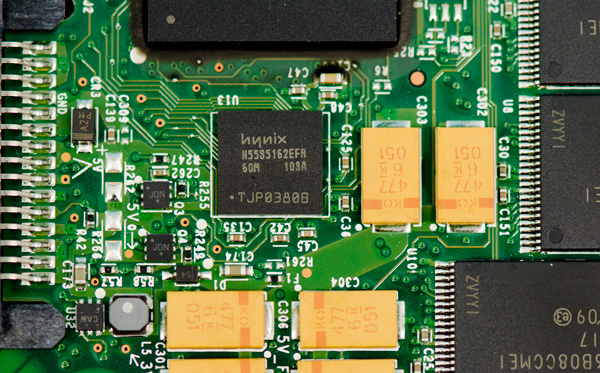









194 Comments
View All Comments
y.a.k - Tuesday, March 29, 2011 - link
Don't forget about notebooks...pvdw - Tuesday, March 29, 2011 - link
Thanks for all the good info and thorough reviews. One of the areas I'm particularly interested in is the performance of an SSD when hosting a Virtual Machine. The reason is that I run Windows Vista (soon to be 7) as a host OS and then XP or Linux for various work stuff in VMs. Any chance of adding some sample VM booting + app loading to the mix?I'm thinking that virtual disks are probably quite random data and so would favour non-SF drives, but I'm not really sure.
NCM - Wednesday, March 30, 2011 - link
I've timed boot and app launches from otherwise identical systems on both SSD and a conventional hard drive on the same workstation (OS X on a current model MacPro workstation). The improvement is by a factor of 3-4. Although we do have a couple of VM setups they're not on the SSD machine, but I'd hope for the speed increase to be in the same range—lots and lots of little files to be read.GoGoGoGo - Wednesday, March 30, 2011 - link
...but not fantastic eitherFor those of us planning to put an SSD in a current laptop (which pretty much makes 6Gbps performace irrelevant) this seems to be an okay option, although not as groundbreaking as the original X-25 a while back.
I do wish more 3Gbps numbers where included for the Vertex3 since for a lot of us that´s what going to matter anyhow. Also, is there a difference in power usage for the Vertex3 when hooked up to a 3Gbps controller or not?
TheSwede86 - Wednesday, March 30, 2011 - link
Hi!Have a friend in the US (Miami) and I am wondering where I can buy this in the US?
The pressrelease said "Best Buy" but on Best Buy's homepage I can't find it.
Anyone seen it "in the wild" and if so where?
Thanks!
Cowbell - Thursday, March 31, 2011 - link
Many new SSDs got built in encryption like the SF series, but the real question I'd love to see more details on Anand, is if the encryption is linked to the ATA password, or perhaps some other software like OCZ's toolbox, but that again is only available on the PRO drives and leaves consumer drives out in the cold. If not then the encryption is only good for fast wipe, nothing else.In addition, I'd love some tests on just how resistant SSD's are to brute forcing the ATA password on non encrypted drives, for instance OCZs SSDs need a power cycle on each 5th attempt to unlock, and how easy it is to read the ATA password in plaintext from the maintenance area of the disk.
To top it all of I'd also love some tests on how easy it is to dump data from SSD flash cells/modules if an attacker were to obtain the disk and disassemble it.
4EverLearning - Monday, May 9, 2011 - link
I second this request. There is much confusion about this topic: what is required to enable encryption, and whether or not it is virtually infallible or a joke.As always, thanks Anand -- great stuff.
paulzeb - Saturday, April 2, 2011 - link
Anand,First, Congratulations for another job well done !
I am a Mac OSX user with MacPro, and I have Just one question:
I read in the review "The Intel SSD 320 Review: 25nm G3 is Finally Here":
"" A side effect of having all data encrypted on the NAND is that secure erases happen much quicker. You can secure erase a SF drive in under 3 seconds as the controller just throws away the encryption key and generates a new one. Intel's SSD 320 takes a bit longer but it's still very quick at roughly 30 seconds to complete a secure erase on a 300GB drive. ""
My experience with Secure erase and Disk Utility on an OCZ Vertex2 is that it take many many minutes depending on the SSD size. Same with a Secure erase and Disk Utility on the Intel X25 G2 Postville.
Will it take only 30 seconds on the new Intel G3 Postville Refresh ???
Thanks for your answer,
Paul
noblemo - Wednesday, April 6, 2011 - link
If I recall correctly, a previous article recommended formatting SSDs with 10-30% of spare area set aside to improve performance. Does this recommendation still apply to the G3?If an extra 20% is under-allocated (for a total of 26.25% on the G3), then the user-available area would be about 220GiB for a 320GB drive, and 110GiB for a 160GB drive.
Omid.M - Wednesday, April 20, 2011 - link
Anand,Can you please comment on this? I recall this recommendation as well.
Does it still hold true? So, if I buy the Vertex 3 or Intel 320 and drop it into my MBP, should I format the drive to have 10-15% area unused (spare) and will that make a significant difference in performance, compared to having 0% spare area (i.e. using SSD as-is, no formatting) ?